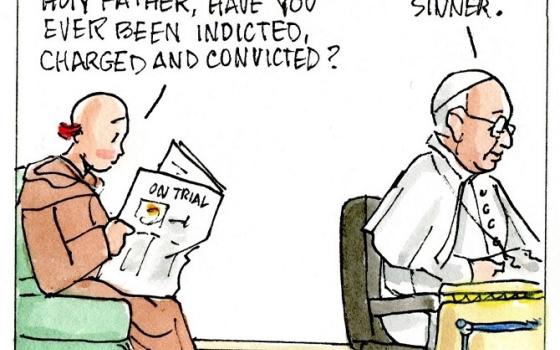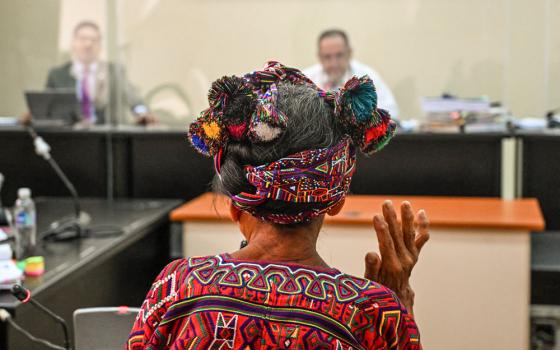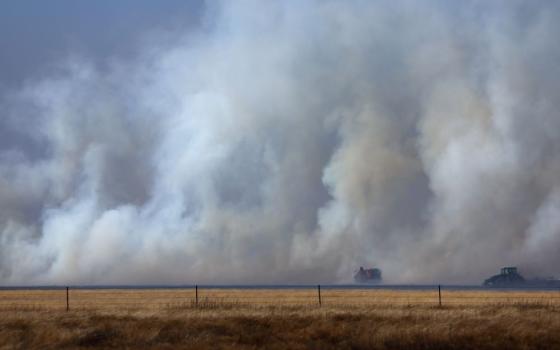On Jan. 22, we drove eight hours south from Johannesburg and Soweto, close to Lesotho, then into KwaZulu-Natal to Pietermaritzburg. Along the way, we passed a side road near Howick where Nelson Mandela was arrested long ago, the arrest that led to his 27 years in prison. A tall, powerful memorial that outlines his face marks the spot. Our drive was magical, through lush, rolling hills, magnificent distant mountains on all sides, and occasional wild animals.
Pietermaritzburg felt like a stepping back into old Victorian South Africa. In the city center, we marveled at the tall orange-brick City Hall with its magnificent clock tower. But we had a specific goal -- a little pilgrimage to the train station where Gandhi was once thrown off a train, an act that led to his lifelong determined fight against injustice and violence. I had come to see the place for myself, and my friends -- Fr. Ray East, his sisters and cousin -- were happy to join me.
Gandhi told the story in his autobiography and in many subsequent interviews. It was June 7, 1893. He had just arrived from India as a young barrister and was on his way to Pretoria for his first case. He had ordered a first-class train ticket by mail and did not know that nonwhites were not allowed to ride in the first-class section.
At 9 p.m., the train pulled into Pietermaritzburg. Train officials received complaints about him sitting in first class. They ordered him to leave, and he refused. So they threw his luggage, which kept his overcoat, off the train. When that didn't deter him, they threw Gandhi himself off the train. He landed on the platform, and the train sped off. It was a bitter cold night. He was freezing. Train officials took his luggage, and he did not dare ask for it back to get his overcoat for fear of further mistreatment.
So he entered the waiting room and sat through the night shivering, trying to decide what to do next. Should he forget about it and keep going, or should he resist this unjust treatment, even if it meant suffering for it?
Gandhi famously chose to resist racism and segregation. "My active nonviolence began from that date," he wrote in his autobiography. That long, cold night and his decision to commit his life to justice was the beginning of everything that followed. This famous episode is the opening scene in the movie "Gandhi."
The train station, the platform and the waiting room are still there, just as they were in Gandhi's day. We pulled up to the strange, beautiful old orange-brick Victorian building on the edge of town. I walked slowly into the large lobby area/waiting room, feeling overwhelmed by its ordinariness and yet the power of what happened here long ago. Many plaques adorn the walls commemorating Gandhi's long night and his subsequent work for justice and peace.
Fr. Ray and I walked out onto the platform then said a short prayer in the waiting room, giving thanks for Gandhi's decision to stay and fight racism and injustice and asking for a portion of his spirit, that we, too, might give our lives in the struggle for justice and peace.
The power of that long, dark night and Gandhi's decision to commit himself to the struggle of justice! Can the rest of us make the same decision and commit ourselves to the struggle as wholeheartedly as Gandhi, even without having to undergo such inhuman treatment?
"The path of true nonviolence requires much more courage than violence. It is capable of being practiced by the millions. It is the soul force within everyone human being." That's the quote featured on the beautiful statue of Gandhi in the city center. According to Gandhi, everyone is called to the work for justice and peace through active nonviolence.
The next day, we arrived in Durban, the sprawling sea city with its tall buildings, luxury hotels, shopping malls and beautiful beaches. Ray and I went for a swim in the warm Indian Ocean, which was exhilarating and yet a little nerve-wracking. South African beaches are known for the presence of sharks, including great white sharks. We swam in a crowded narrow stretch on north beach, where we were watched by several lifeguards who told us that a little farther out, nets protected us from sharks. Ray kept telling me how wonderful it was to be baptized anew in the Indian Ocean, but I kept a worried eye on the horizon for sharks.
After our swim, we were picked up by Richard Steele, a longtime activist, Christian anarchist, former staff member for the Gandhi ashram and former staff member of the Fellowship of Reconciliation in South Africa during the 1980s and 1990s. Richard was arrested and imprisoned for one year around 1980 for refusing to serve in the military of the racist South African government. As a white conscientious objector, Richard posed a great threat to the apartheid regime because he broke the racist propaganda that proclaimed that all whites supported apartheid.
Richard drove us north into the surrounding suburbs and townships toward Inanda, where Gandhi created his first ashram in the late 1890s. He called it Phoenix Settlement. There, on a quiet hill about 18 miles from the city center, Gandhi set up a large interfaith community of nonviolence with homes, gardens, a national newspaper, a school and a printing press. This became the base for his satyagraha campaign against racism and injustice.
Walking through the grounds of Gandhi's first ashram was another inspiring moment for me. A hundred years ago, his little community of houses would have been surrounded by miles of green rolling hills; today, thousands of impoverished squatter huts and tin shelters fill the whole area as far as the eye can see. The poverty is striking compared to the wealth one finds in Durban.
The house of the printing press, where Gandhi published his popular newspaper "Indian Opinion," and a few other buildings still stand, but Gandhi's original house was burned down in 1985 during the riots from neighboring townships. An exact replica was later built on the spot and is now a museum marking Gandhi's life in South Africa. Richard lived there and oversaw the ashram in the 1980s; he told us of Gandhi's work and their current efforts to keep Gandhi's teachings alive. Although I was not able to visit the grounds of Gandhi's second ashram, Tolstoy Farm, built outside Johannesburg in 1909, coming here was the fulfillment of a lifelong dream and encouraged me to carry on my own journey of nonviolence and peace.
Though we visited Durban, we actually stayed for several nights far away in the countryside at a small nature reserve, where we rented a little house. There, along the rolling green hills, we saw dozens of zebra, antelope, monkeys, wildebeests, springbok and other creatures. Rising at 5 a.m. with the morning sun, I walked alone each morning through these glorious South African hills. Dozens of nearby zebra grazed and watched me, and I felt renewed, reinvigorated, healed and inspired to carry on the journey of peace, in the spirit of Gandhi and Jesus.
Yes, South Africa is one of the most beautiful, amazing places on earth.
[John Dear's new book, The Nonviolent Life, is available at paceebene.org and Amazon.com. John will speak Feb. 2 in Sedona, Ariz., then in California in Pasadena, Reedley, Fresno, Palo Alto, Davis, Sacramento, and Claremont. He will lead a weekend retreat, "Lotus in a Sea of Fire," with Roshi Joan Halifax Feb. 28-March 2 at the Upaya Zen Center in Santa Fe, N.M., and will speak March 9 at Riverside Church in New York. He will give the keynote address with Rep. John Lewis (D-Ga.) at the Ecumenical Advocacy Days conference March 21 in Washington, D.C. For more information, go to John's website.]




